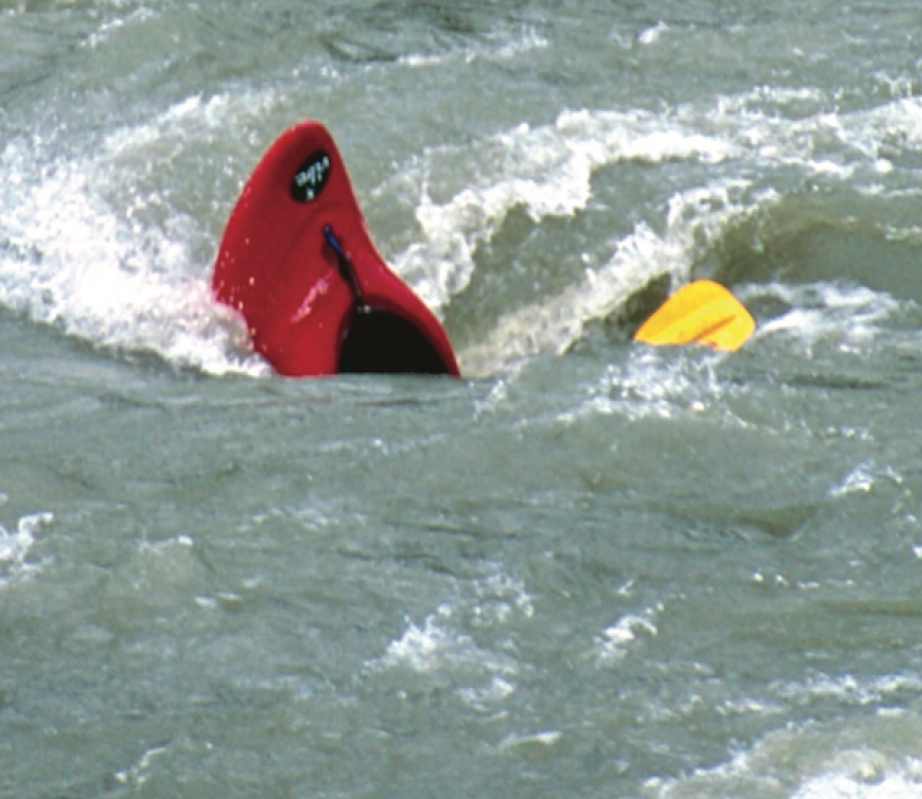Whirlpools have always held a strange fascination as black-hole vortices into which things disappear and don’t return. Rumors of thirty-metre fishing boats disappearing in seconds, counter-rotation whirlpools in the southern hemisphere, and the elusive “floater” that never flushes down, have all been dispelled as local folklore and myth. Or have they?
To river-people, whirlpools have always had a mystic aura surrounding them. However, it is possible to understand these behemoths and the forces that influence them. Whirlpools are, believe it or not, consistent river features. Playing in whirlpools adds a new dimension to river running, building your understanding and making you feel more comfortable when acciden- tally dropping into them. Playing in whirlpools increases bracing and rolling abilities, and sometimes, in a really big one, increases your lung capacity.
WHIRLPOOLS: MORE THAN YOU WANTED TO KNOW
Formation
Whirlpools generally occur along strong eddylines where two strong, opposite flowing currents collide. When the two currents converge, the centrifugal force (force away from the centre of the circle) creates a low-pressure area in the centre of the circle. Water wants to move from high-pressure areas to low pressure areas and this is what creates the centripetal force (force towards the centre of the circle) in the whirlpool establishing the spin-momentum of the water. Gravity affects the spin-momentum creating the downwards flowing tendency of the vortex, and accentuating the spin.
Progression
Once a whirlpool forms, its longevity depends on its spin-momentum and interaction of the two opposing currents. Very strong opposing currents form a whirlpool which spins extremely fast, and due to the increased centrifugal and centripetal forces, a very tight, deep whirlpool is the result. Slow moving, opposing currents form a very shallow, wide whirlpool without much downwards-sucking motion.
Whirlpools move downstream along the eddy line. The reason is, downstream flowing current always moves faster than the upstream flowing back eddy. The whirlpool progresses downstream along the eddyline because of the difference in force between the two currents acting on the vortex.
Dissipation
Whirlpool dissipation is a result of a loss of spin-momentum and the two opposing currents no longer being in opposition. The friction of the water on itself causes the spinning forces to stop. Dissipation of the whirlpool occurs as whirlpools move laterally away from the eddyline into the downstream or eddy current, or as they move to the downstream end of the eddy where the eddy current is not strong.
PADDLING INTO THE VORTEX
The Slingshot Technique
The first thing to know about kayaking around whirlpools is that a whirlpool on river left will always spin counter-clockwise and a river-right whirlpool will always spin in a clockwise direction—the bottom of the whirpool is flowing into the eddy. This knowledge about whirlpool spin direction, and knowing that whirlpools form and move downstream, enables you to actually use whirlpools to accelerate into, and out of, eddies.
To enter a strong eddy with a large boil-line, paddling into the eddy just downstream of the center of the vortex allows you to use the laterally flowing water as a slingshot to increase speed into an eddy. Paddling out of an eddy and into the current, being just upstream of the whirlpool vortex will increase lateral momentum into the main current. This technique enables you to cross eddylines, which would otherwise be very difficult to cross due to large boils.
Whirlpool Pirouettes
Whirlpool pirouettes are an extremely fun and unique kayaking experience. Pirouettes are very easy to initiate and maintain because of the sucking action of whirlpools. To initiate, simply expose your bow or stern to the centre of the vortex. Using cross-bow pirouette strokes or stern squirt strokes get the boat vertical and spinning. Being able to bow stall or continue your squirt rotation is beneficial, though not necessary.
Mystery Moves
Mystery moves, or disappearing underwater while still in the boat, are easy with whirlpools. To maximize downtime keep the kayak sitting flat, which increases the amount of surface area the river can use to pull the boat under. Important note: once under water, spinning the boat using the paddle, and sitting upright, help you to return to the surface upright.
Getting Worked
Flipping in whirlpools is part of the freestyle experience. Waiting upside down to be released by the whirlpool is not the best option. Although this may work, provided the whirlpool dissipates quickly.
When upside down in the bottom of the vortex, the water around the edges of the whirlpool is spinning faster than the upside down kayaker. Reaching to the surface and changing the blade angle to catch faster-flowing water, the current in the vortex assists your roll by increasing the water-pressure on the paddle blade.
Oh Yeah, Safety for the Black Hole
There are two things necessary before playing in whirlpools to ensure the whirlpools will be a fun experience. The first is to choose a good location. Big whirlpools are fun, provided they form quickly and dissipate quickly. Tight, deep whirlpools will maximize downtime, which can be a good thing or a bad thing, depending on how long the water continues to revolve.
Secondly, remember that a whirlpool is startlingly similar to a black hole—an object whose gravity is so strong that the escape velocity exceeds the speed of light. Some whirlpools can suck a paddler and kayak under for 15 seconds. Large whirlpools like this are incredibly dangerous to paddlers out of their boat. Prepare mentally to stay in your boat and have a good spray deck. Swimming is not an option.




